

Damion Smy
Boxy new KGM Musso unveiled to take on HiLux and Ranger ahead of Australian launch
8 Hours Ago
Where expert car reviews meet expert car buying – CarExpert gives you trusted advice, personalised service and real savings on your next new car.
Kia has a new hero.
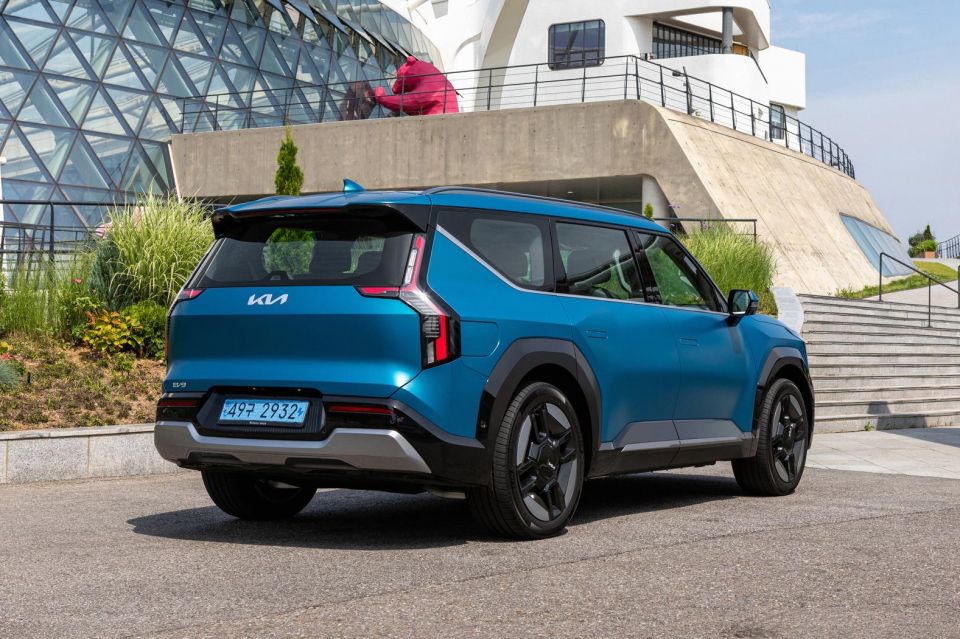
The 2024 Kia EV9 looks like a concept car come to life, but it’s more than just a style statement.
On the outside, it previews the design language that will filter through the Kia brand as it expands its range of electric cars with looks lifted directly from the world of concept cars.
It looks a bit over-the-top in images, but it’s a very handsome car in person – trust us, you’ll know when one appears in your rear-view mirror.
On the inside, it sets the tone for what’s to come as well – not only when it comes to how it looks, but when it comes to the recycled materials that feature throughout.
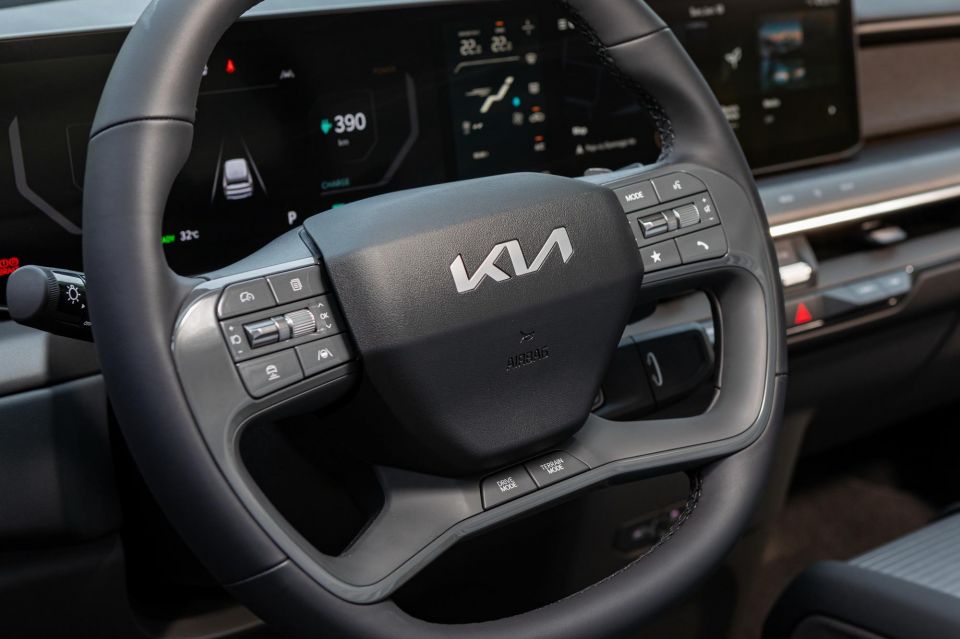
Then there’s the price. In Australia this will be the most expensive Kia ever, with an expected sticker well north of $100,000 before on-road costs at the top end of the range.
We flew to South Korea for a first taste of the EV9 before it hits Australia later this year – and came away impressed.
We don’t know just yet, but we do know it’ll be expensive.
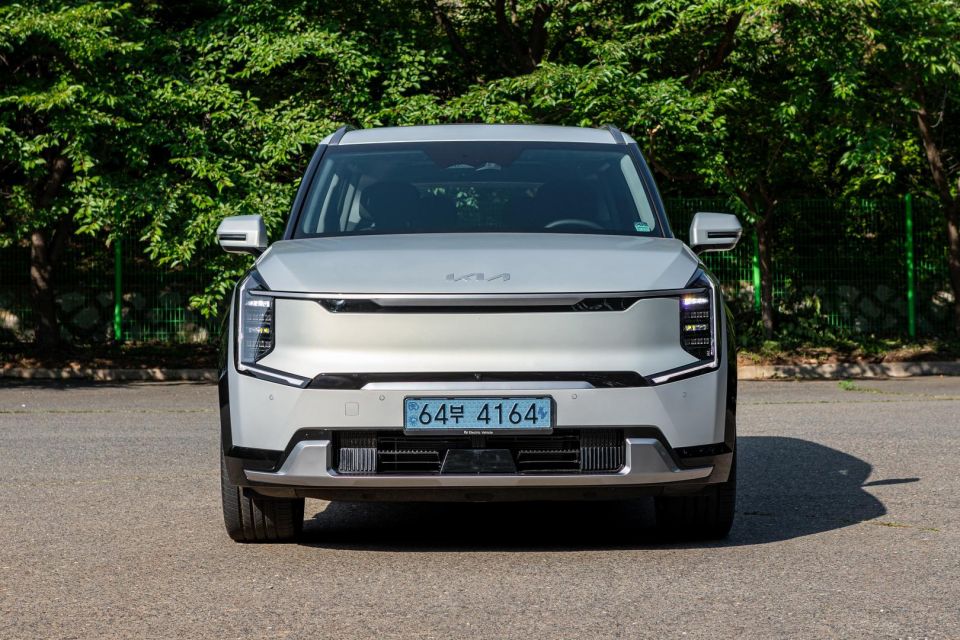
Expect prices to start around the $90,000 mark for the rear-wheel drive Air with its smaller battery, and extend beyond $100,000 for the range-topping GT-Line AWD.
At the bottom end, that would pit it against internal-combustion cars such as the Mazda CX-90 D50e Azami ($93,865) and Volvo XC90 B5 Plus ($95,990).
Previous comments from Kia Australia executives point to prices topping out at around $130,000 before on-road costs. That would put it head-to-head with the Polestar 3 ($132,900) and BMW iX xDrive40 ($135,900).
The most expensive Kia is currently the EV6 GT, with a sticker price of $99,590 before on-road costs.
Buy your new car without the stress. It's fast, simple and completely free.

Great service from Travis and team, second time I have used this business would not hesitate to recommend them to anyone
Craig C.
Purchased a Ford Ranger in Sunshine Coast, QLD
CarExpert helped Craig save thousands on his Ford Ranger, now let us save you on your next new car.
Find a dealBig, comfortable, and high-tech, the EV9 feels like a worthy flagship for Kia from the second you open the door.
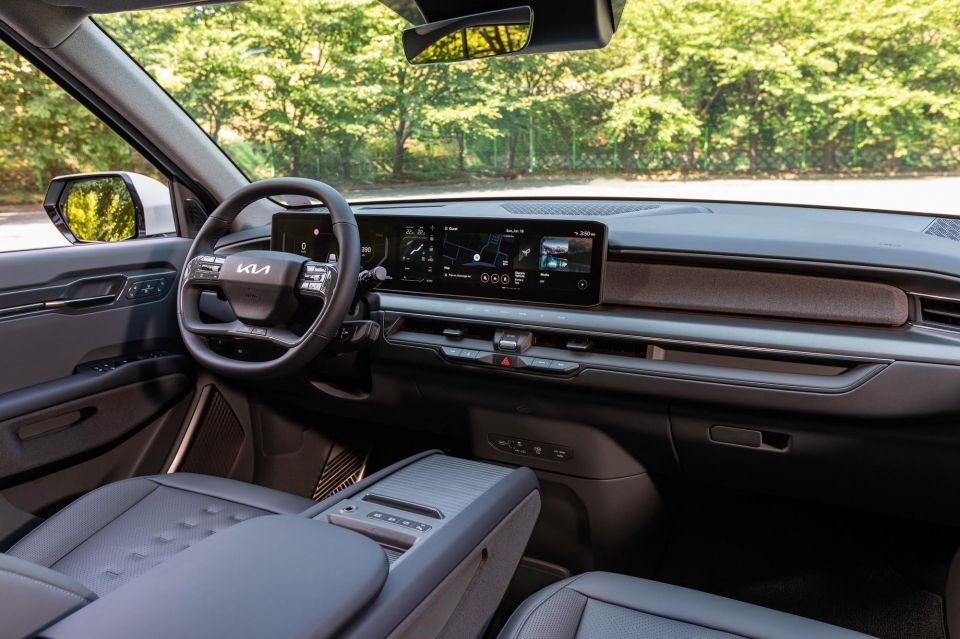
You sit high in well-stuffed armchairs trimmed with quality leather, and the view over the broad bonnet is Range Rover-like. We drove from one side of Korea to the other… and back again in the EV9 without so much as a hint of numb bum or aching back.
As is the case with other e-GMP cars, the steering wheel doesn’t extend quite far enough out from the dashboard, but that’s our only real gripe.
There’s a real sense of space, borne not only of the sheer size of the EV9, but of the flat floor, tall windows, and simple dashboard. It looks and feels like a concept come to life.
Kia hasn’t fallen into the trap of killing buttons wholesale. There’s a series of shortcuts below the central touchscreen allowing you to hop from function to function, and the four toggles flanking the hazard light switch allow you to fiddle with the climate control without taking your eyes off the road.

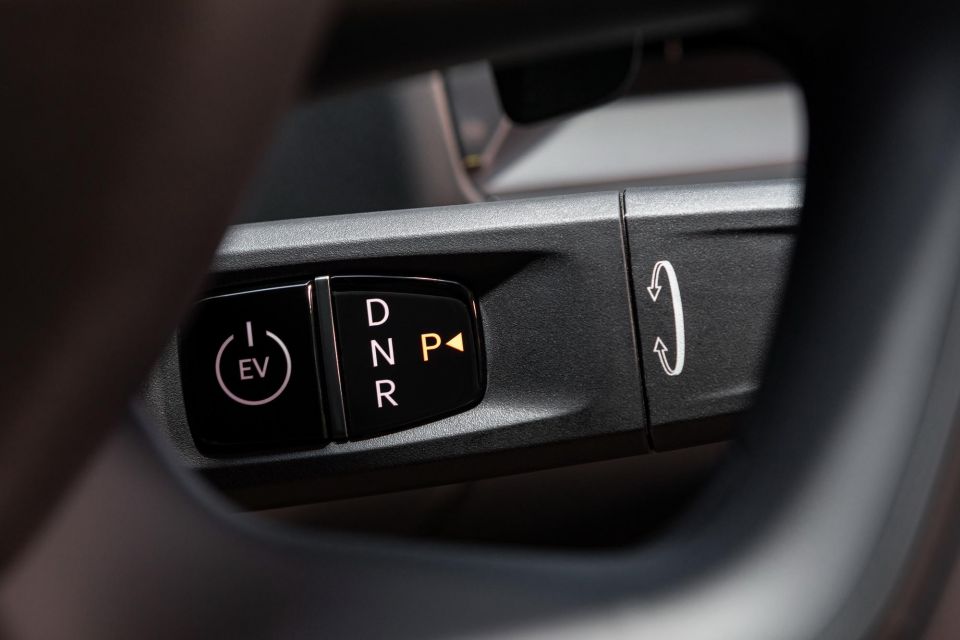
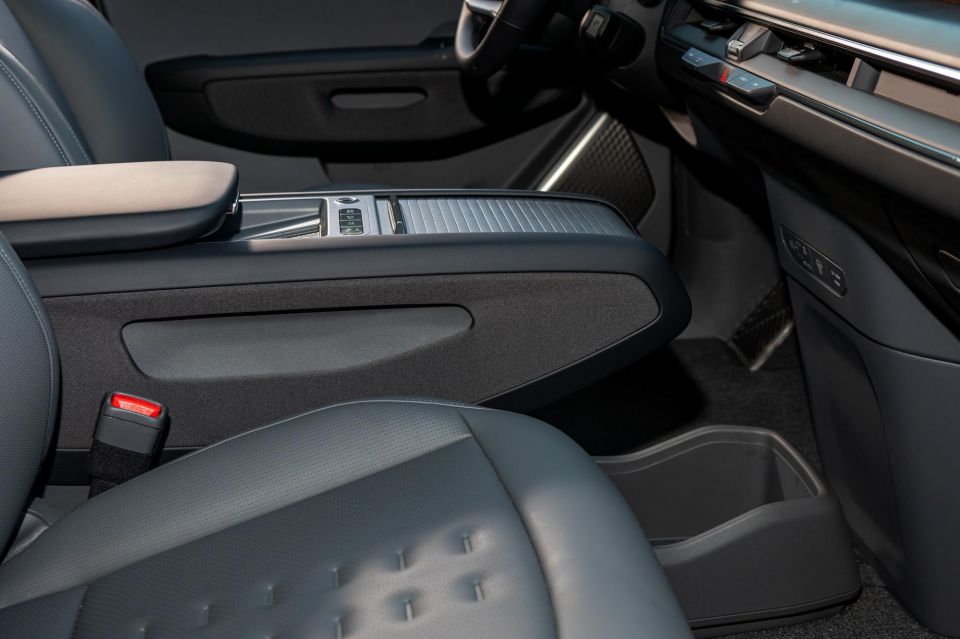

Yes, some functions are still hidden in the little display between the driver’s screen and the touchscreen, but you seldom need to use them. That’s a win.
The EV9 debuts a new infotainment system for Kia, and it’s an improvement on the setup currently offered across the range.
The graphics look more modern, and it’s easier to navigate – with fewer small icons, a shorter reach to the Android-style home/back buttons, and a degree of differentiation from the setup in cars like the Picanto. Wireless Apple CarPlay and Android Auto are still a no-show, though, which just isn’t good enough in 2023.
Storage space is abundant up front. The flat floor allows for a handbag or backpack-sized space under the central tunnel, and the tunnel is home to cupholders, a wireless phone charger, and a spacious central bin.
Oh, and the Meridian sound system fitted to our testers absolutely slaps. It’s punchy and clear, as we’ve come to know and love of systems wearing the same brand name from more expensive European and British luxury cars.
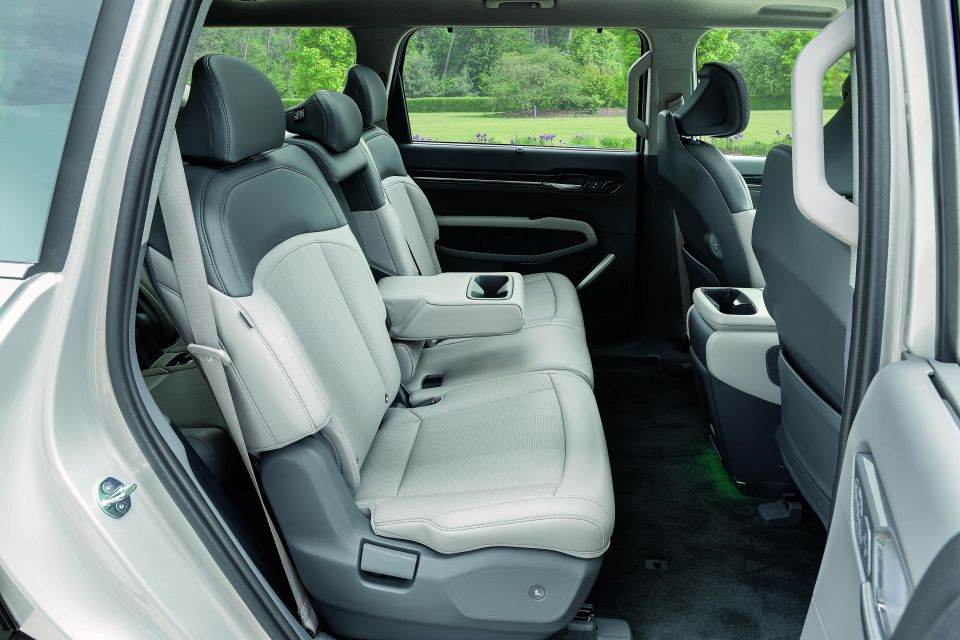
Kia has thrown the kitchen sink at the second row. A six-seater is available elsewhere in the world, but it won’t come to Australia. Although that means we miss out on swivelling, massaging captain’s chairs, even the three-seat bench that’s coming Down Under is pretty plush.
The outboard seats in the top-spec cars we drove are heated and cooled, and even at six-seven I had plenty of headroom and legroom. The oversized, concept-car windows mean outward visibility is excellent, and the big rear doors make it easy to get in and out.
Yes, it’s a fashion statement, but it’s also practical.
Roof-mounted air vents with dedicated controls for rear passengers, manual sun blinds on the rear windows, USB ports, and a massive storage bin beneath the central tunnel round out the amenities back there.
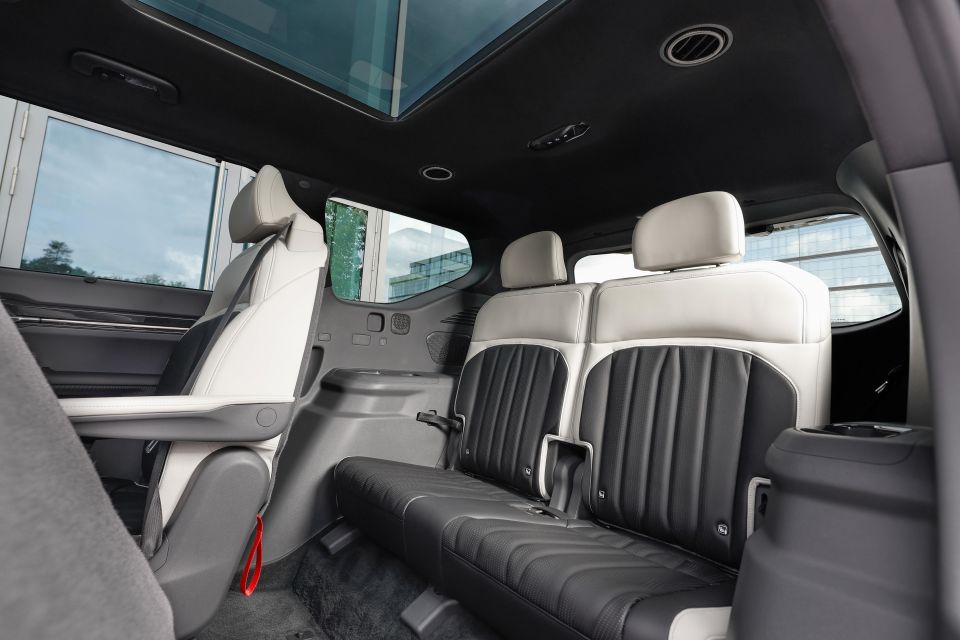

As for the third row? It’s more Hyundai Palisade than Kia Carnival back there, but the sixth and seventh seats really are usable.
Access is simple enough once the second row seats are tilted and slid, and once back there you have enough legroom for kids or younger teenagers… provided the bench is slid forward. With it slid back there’s absolutely no space, as is the case in most large SUVs with three rows of seating.
Cupholders, roof-mounted air vents, and USB ports are all welcome back there – as is the fact the curtain airbags extend all the way to the third row.
The base Kia EV9 features a 77.1kWh lithium-ion battery pack, feeding a 150kW/350Nm electric motor on the rear axle.
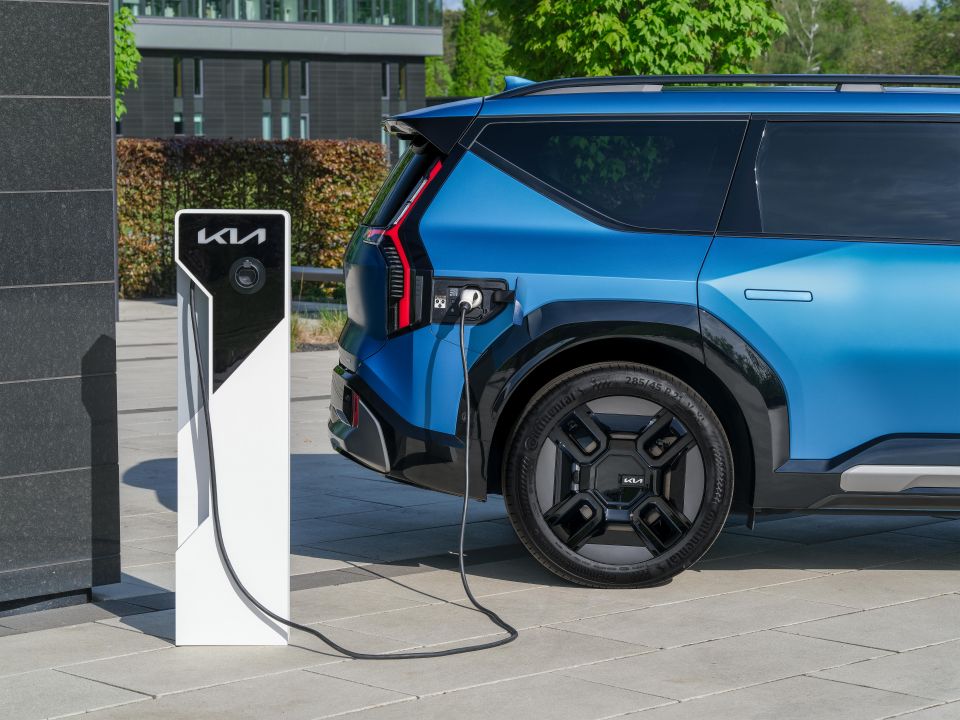
Claimed range is 418km on the WLTP test cycle, and the 100km/h sprint takes 8.2 seconds.
Moving to the long-range battery pack ups capacity to 99.8kWh. It’s offered with rear-wheel drive, good for a claimed 541km of range on the WLTP test cycle and a 9.4-second sprint to 100km/h.
It’s also available with all-wheel drive. The dual-motor setup makes a combined 283kW of power and 600Nm of torque, although that can be upped to 700Nm with an upgrade purchased through the Kia Connect store.
Claimed range is 497km on the WLTP test cycle, and the 100km/h sprint takes a claimed 5.3 seconds with the 700Nm tune.
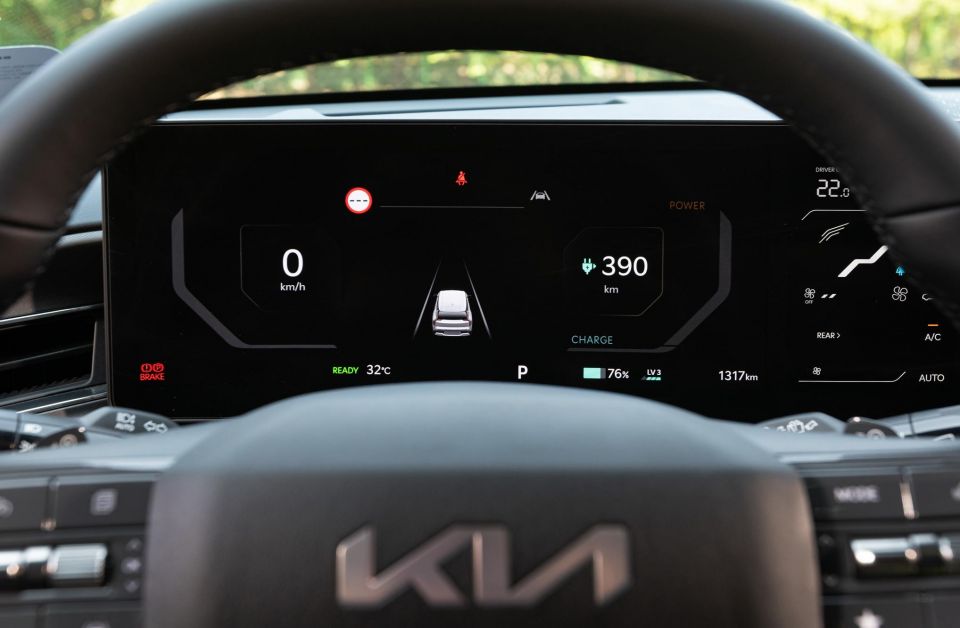
The best economy we saw was 5.5km per kW, equivalent to 18.2kWh/100km – the worst was around the 4.0km per kW mark, equivalent to 25kWh/100km.
All three models are capable of fast charging at up to 350kW on a DC public plug, although in the real world we’ve seen Kia and Hyundai electric cars top out at around 230kW.
It also features V2L capability that’ll allow owners to plug household appliances into a 3.6kW three-pin socket, and Kia is selling the ability to plug into the grid (through a suitable wall box) through its subscription store.
The EV9 we drove in South Korea was a top-spec car riding on 21-inch wheels. Final specifications for Australia haven’t been locked in, but we do know the car we get Down Under will feature a bespoke suspension tune.
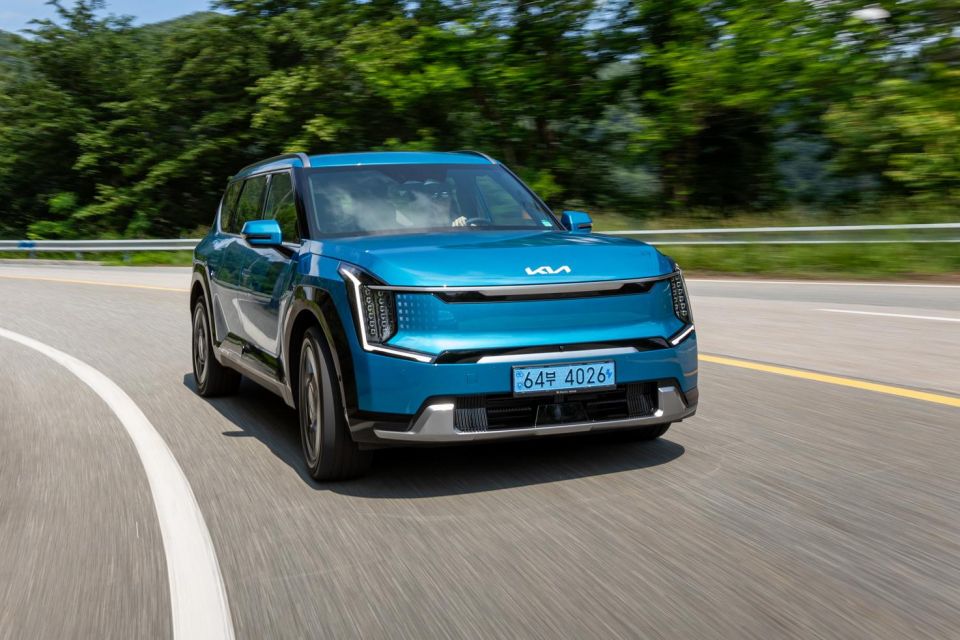
At low speeds the Korean car was quite firm, with the oversized wheels slapping into potholes in a way that slightly undermines its luxurious bent, but at higher speeds it settles down nicely. There’s no big car float, and it takes car of bigger crests and dips in one clean movement.
South Korea is about 99 per cent highway, based on our launch drive, and at 100km/h the EV9 feels rock solid.
Kia has clearly made a real effort to keep the EV9 quiet. There’s no noise from the motors, naturally, but tyre noise and wind noise are also effectively kept at bay. Besides a hint of wind rustle around the front pillars, it’s dead quiet inside.
We’ll need to experience the car on Australian B-roads before passing final judgement, of course.
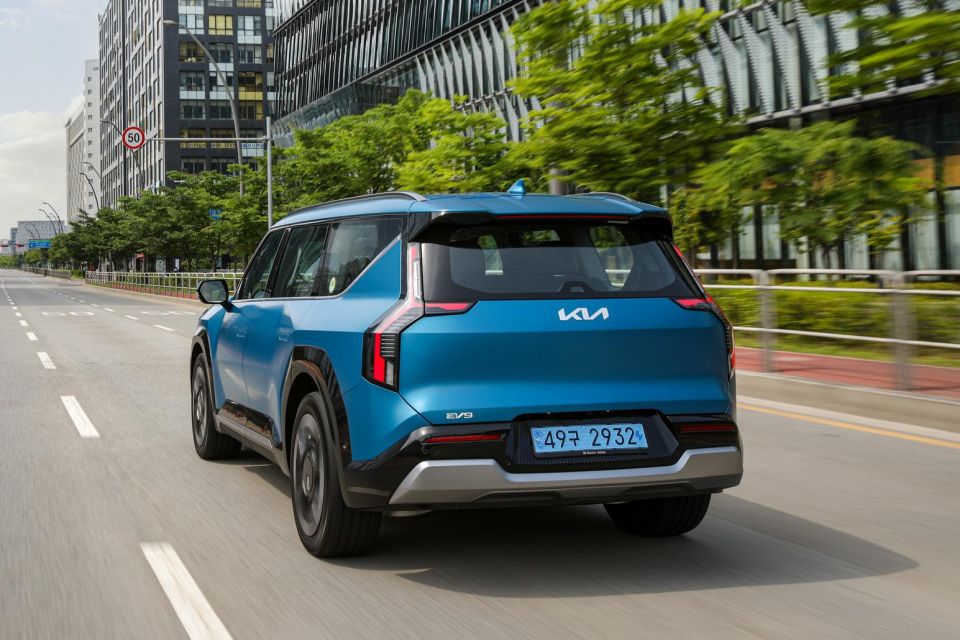
Performance in the top-spec all-wheel drive car is impressive given the EV9 weighs around 2700kg. It won’t snap your neck like a Tesla Model X off the line, but it’ll pin you back in your seat and keep you there all the way to the legal limit and beyond. All our testers featured the 700Nm motors.
You can actually feel a hint of tugging through the steering wheel when you mat the throttle on wet roads, before the clever motor control software shuffles torque around to keep you tracking straight. Torque steer in a 2.7-tonne SUV? There’s only a hint, but yes – welcome to the electric future.
It’s more than just a straight line bruiser; the EV9 handles better than expected. The body is well controlled when you tip it into a corner, and the all-wheel drive traction means you can get on the power and it doesn’t all fall to pieces.
The combination of physical and regenerative braking means it pulls up better than you’d expect, although there’s no escape from the fact it’s a big, heavy family SUV on tight roads.
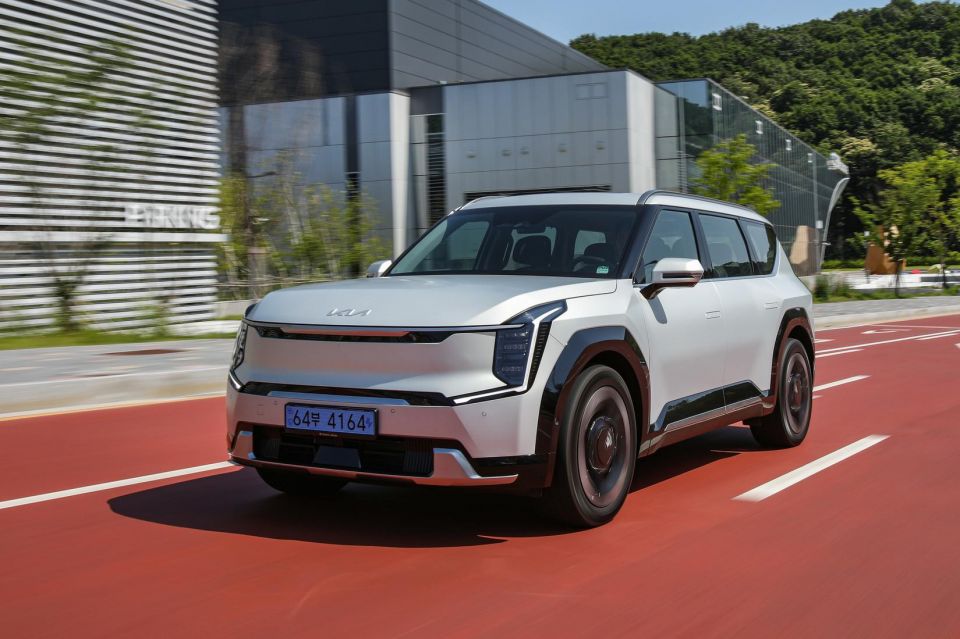
Speaking of regenerative braking, the way the system works feels consistent with what we’ve come to know of the EV6. It can be toggled from non-existent to the full, one-pedal experience using paddles behind the steering wheel.
Once again, you have to manually activate iPedal mode every time you start the car. It’s hard to understand why, given one-pedal driving is an appealing part of the electric car experience – and one most other brands make the default.
When you are using it, the regenerative braking system is smoothly and smartly calibrated. Beyond the occasional lurching moment when it reactivates coming out of cruise control,
Given we drove the car in Korea, the EV9 featured Kia’s next-generation highway driving assistant.
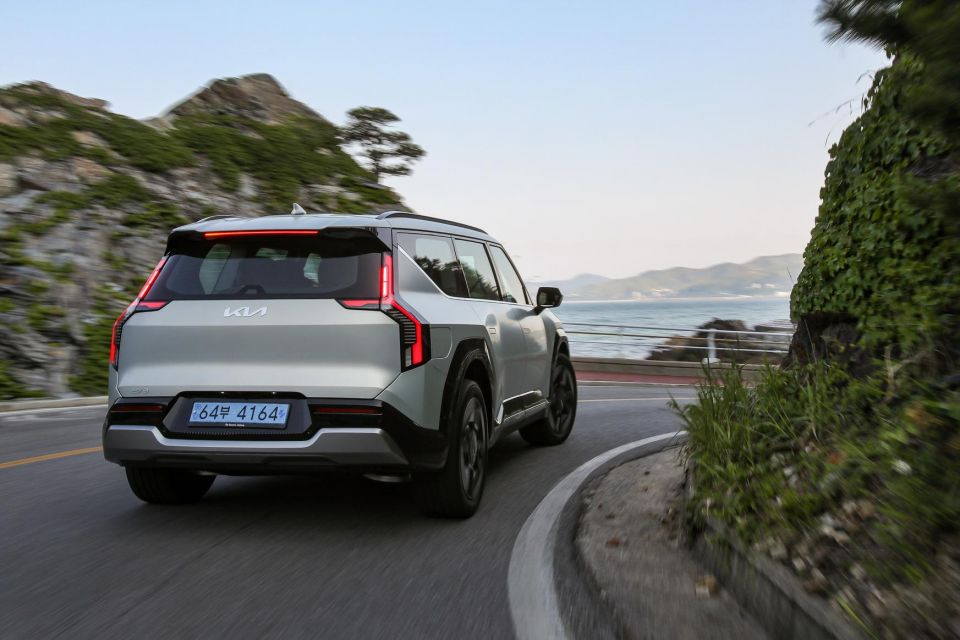
Where expert car reviews meet expert car buying – CarExpert gives you trusted advice, personalised service and real savings on your next new car.
Along with the same lane-centring and lane-keep systems offered in the current Kia range, the more advanced setup changes lanes for you if you indicate, the lane markings are correct, there’s nothing in your blind spot, and you don’t turn the wheel.
It works well, helping ease the load on long highway drives, although it’s not clear if we’ll be getting the full suite in Australia.
Specifications for the Australian Kia EV9 line-up are yet to be locked in. It’s also not yet on sale in many markets similar to ours, which makes it challenging to guess exactly what the car will feature locally.



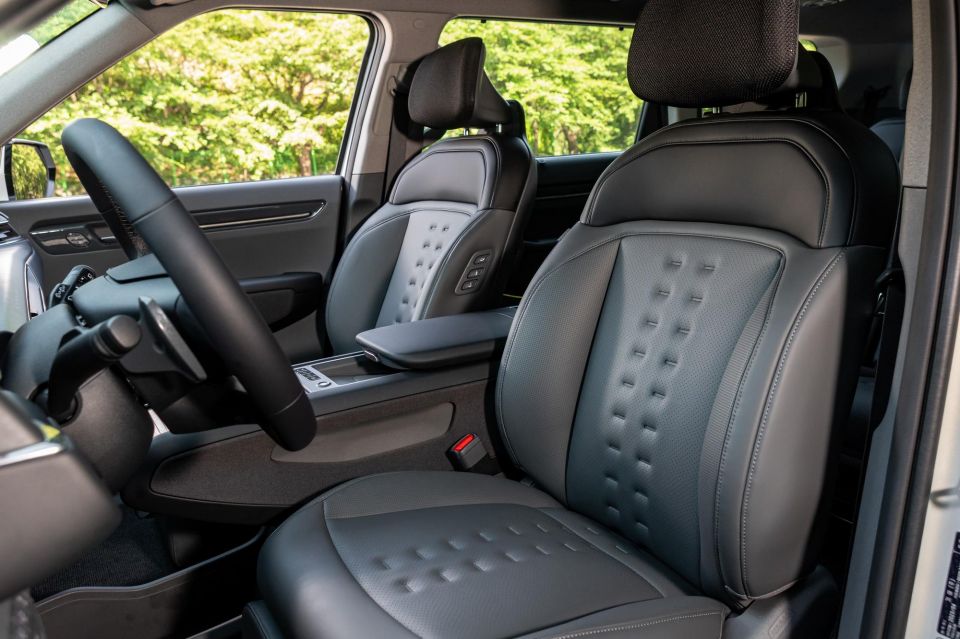
In Korea, standard kit includes:
EV9 Earth adds:
The GT-Line isn’t yet on sale in Korea, but features a unique range of two-tone finishes behind the wheel.
A choice of 19-, 20-, and 21-inch wheels are available depending on specifciation.
The EV9 hasn’t been crash tested yet, but Kia says it’s targeting a five-star Euro NCAP rating.
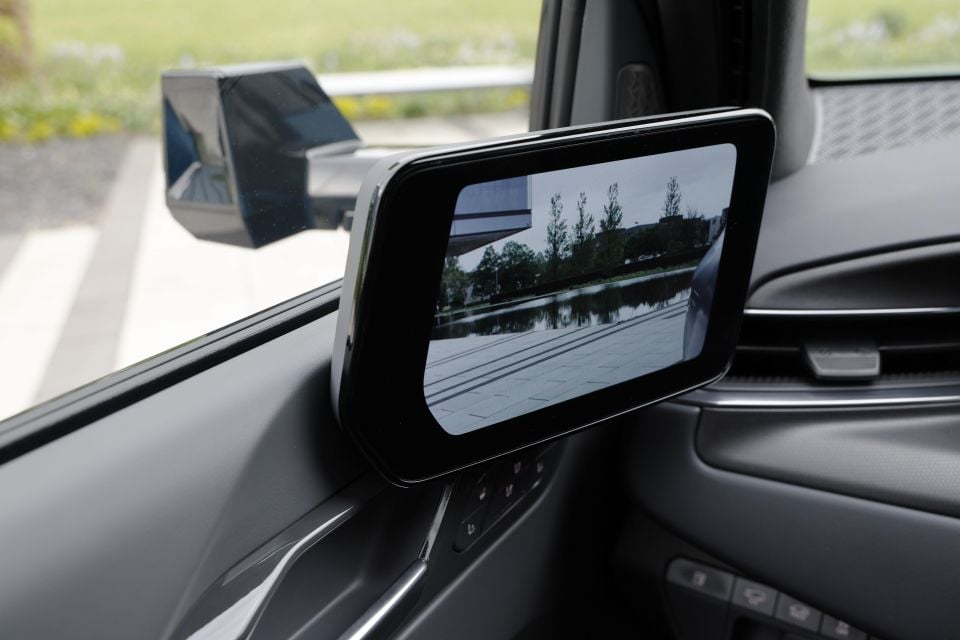
A full range of safety features will be available, including:
Kia has also paid careful attention to passive safety, citing “the world’s first patent-pending B-pillar connection structure technology featuring an extended overlap between crash barrier and side sill”.
The EV9 will be backed by a seven-year, unlimited-kilometre warranty like the wider Kia range.
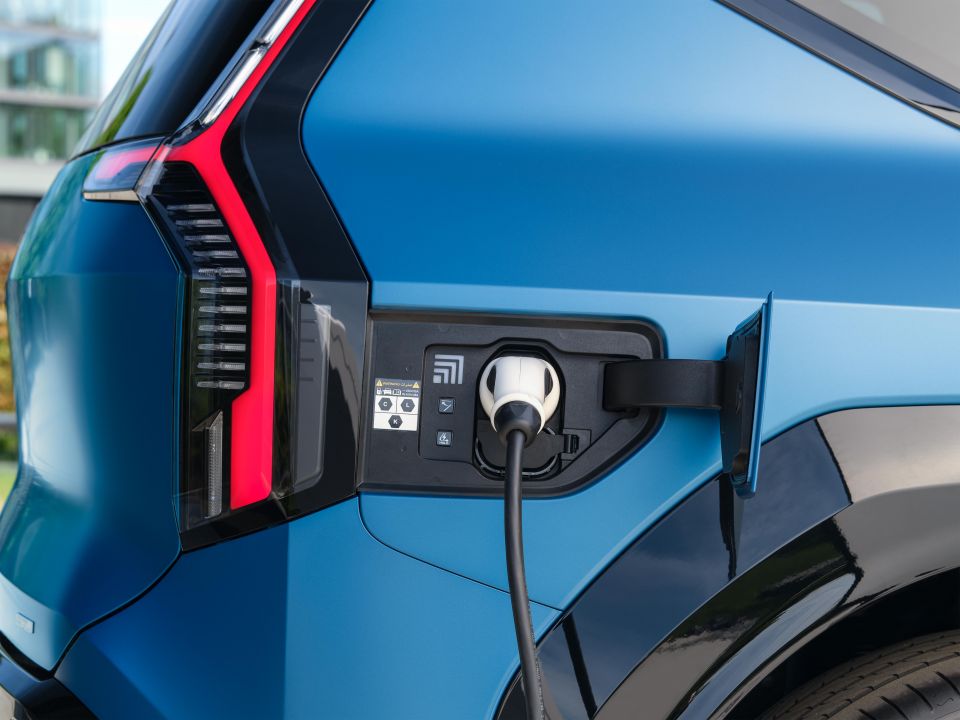
Service pricing hasn’t been confirmed, although Kia engineers confirmed pricing should be similar to that of the related EV6.
Kia offers three prepaid service plans for the EV6, with three years priced at $594, five years priced at $1089, and seven years priced at $1584.
The EV9 is a worthy flagship for Kia.
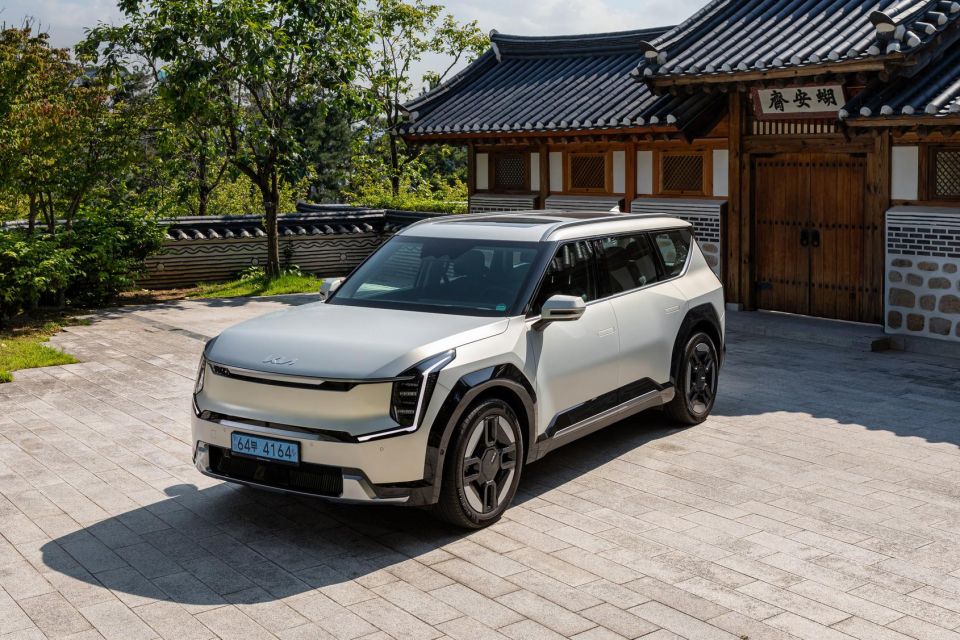
From the concept-come-to-life looks to the modern interior, it’s a confidently executed family SUV for the electric era.
Our drive was heavily skewed to smooth Korean highways, so we’ll need to spend some more time behind the wheel when the EV9 hits Australia to lock in our final thoughts – but it’s hard to see its blend of performance, refinement, and comfort struggling Down Under.
It’s not going to be a huge seller. We’ve reported just 100 units per month are coming to Australia in 2024, following an initial allocation of around 400 units at the very end of this year.
But there’s no doubt it’s going to make a few people think differently about Kia when its imposing nose appears in their mirrors.
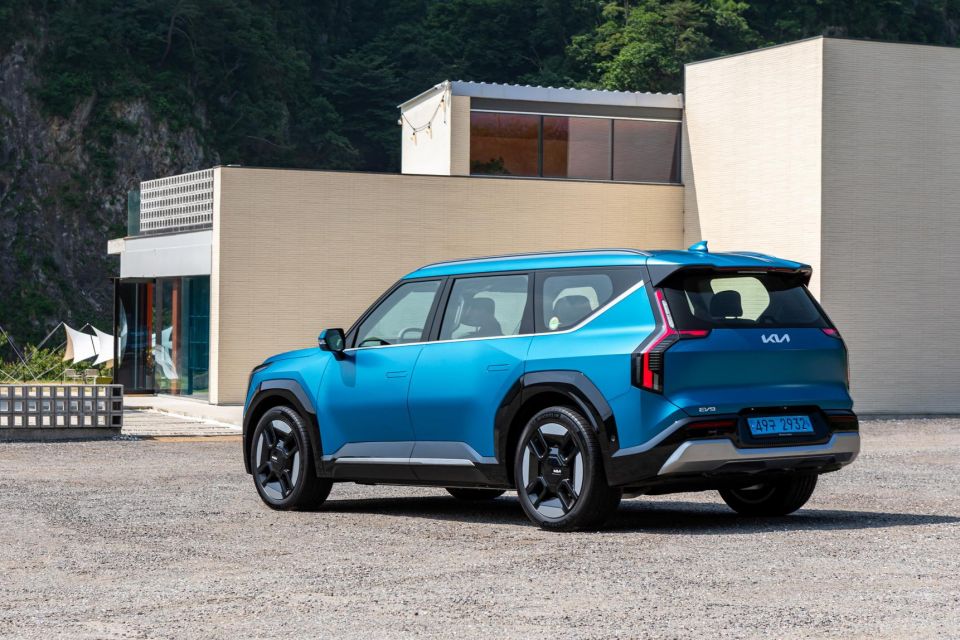
Click the images for the full gallery
MORE: Everything Kia EV9
Where expert car reviews meet expert car buying – CarExpert gives you trusted advice, personalised service and real savings on your next new car.
Scott Collie is an automotive journalist based in Melbourne, Australia. Scott studied journalism at RMIT University and, after a lifelong obsession with everything automotive, started covering the car industry shortly afterwards. He has a passion for travel, and is an avid Melbourne Demons supporter.


Damion Smy
8 Hours Ago


Damion Smy
9 Hours Ago


Damion Smy
11 Hours Ago


Damion Smy
12 Hours Ago


Damion Smy
14 Hours Ago


Damion Smy
15 Hours Ago